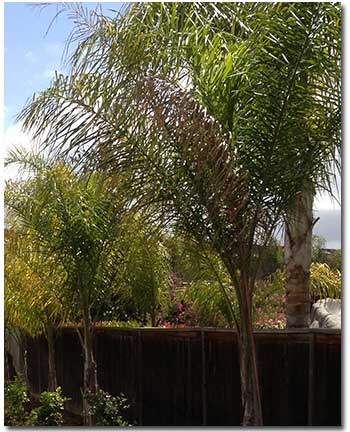Care and Maintenance of Palm Trees

We’re talking about trees now; we’ll leave hand care to the salons. Proper care and maintenance of your palm trees is actually pretty easy. As far as trees go, the only type of tree that requires less attention is the conifer. The main points to remember are fertilization, irrigation, mulching, and a bit of pruning. Think of it as a spa day for your palm tree.
Fertilization
Palms are hardy plants, but they do need a boost once or twice a year. They’re particularly sensitive to certain deficiencies, namely nitrogen, potassium, magnesium and micronutrients. Fortunately, there are “palm special” fertilizers that focus on these deficiencies. Your local Grangetto’s recommends Apex® Palm Special, Gro Power® Palm & Tropical or Grow More® Palm Food. For the organic grower, Dr. Earth® Palm, Tropical & Hibiscus fertilizer is a good choice; simply follow the directions on the package. Your palms are experiencing nitrogen deficiency if all of the leaves are yellowing. Potassium and magnesium deficiency is present on older leaves only and appears as orange flecks with yellowing leaf edges.
Micronutrient deficiencies only affect the newest leaves; they appear stunted or exhibit what’s called interveinal chlorosis, the inability to properly process chlorophyll. In that case, they’ll be a much paler green than normal, but the veins will be the usual green. This deficiency can be caused if the soil pH is incorrect for the type of palm, or if there’s low root activity. Low root activity can be caused by a multitude of factors from low temperatures to physical damage, over-watering and poor drainage – which leads to poor oxygenation.
Irrigation
This is vitally important for healthy, happy palm trees. Palms are sensitive to moisture levels; over-watering is just as bad as under-watering. This is especially true for recently planted palms or palms that are just establishing a root system. Contrary to popular belief, do not rely on a calendar for “regularly-scheduled” irrigation; this will only result in over-watering. To help them establish root systems, water newly-planted palms on a daily basis. Water large, established palms when the soil two inches down is dry to the touch. When watering these palm trees, take the soil type into consideration, too. The goal is to moisten the soil one foot down. If the soil is heavy or clay, that means applying two to two and a half inches of water; for light, sandy soil, only apply one to one and a half inches. It’s best to break this up into a few smaller irrigations to avoid water run-off.
Mulch
Shortly and sweetly, mulching your palms is easy. First, clear all ground cover – and shrubs – within two feet of the palms base. Then, apply organic mulch, three inches deep, around the base and you’re done. Grangetto’s recommends Kellogg® Gardner & Bloome® Soil Building Compost, which is perfect for the job, not to mention ORGANIC!
Pruning and Sanitation
Moderation is the key phrase. Only remove dead leaves; pruning healthy leaves may damage the tree. Imagine a horizontal line running through the middle of the heart from three o’clock to nine o’clock. Never remove leaves above this line. Pruning should be done with the proper tools, such as a hand saw or pole pruner for taller palms, not a chainsaw. Palms also fruit (think coconuts) and that can cause sanitation and safety issues. Smaller fruits, such as those of the Queen Palm, create an enormous amount of litter when they fall. The safety concerns of falling coconuts are pretty easy to imagine. The fruit stalks can be pruned when pruning the dead leaves. Proper pruning keeps palms healthy and your yard safe and clean.











